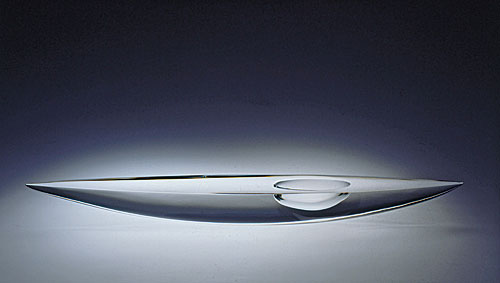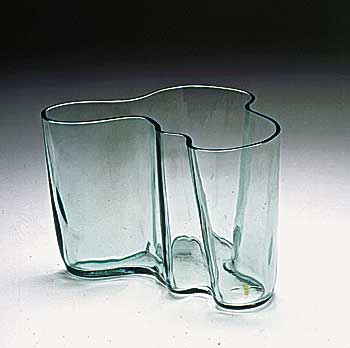When we look at a glass object, what strikes us first is its fragility, delicacy and apparent lack of consistency. Instead, we should go beyond appearances and, through a more detailed analysis, consider the strength, resistance and hardiness of this material.
Not to mention its other qualities: its primordial malleability, its impenetrability, its wholesomeness and its undisputed usefulness. And finally, if we investigate the historic-artistic side, we discover a universe of shapes and techniques which followed on one after the other through the centuries and which elevated glass creations to works of art, real icons of international design.
These are the feelings which bubbled away and accompanied me in my visit to the Museum of Glass in Riihimäk, a small town in southern Finland. While I was proceeding through the lively and multi-shaped word of glass, my attitude slowly changed and I succumbed to what insiders call “the fascination of the glass”; I was struck by the shapes, the colours, the originality and the concreteness and energy at the base of every single piece of work.
An important stimulus to my interest was provided by the Museum’s Director, Doctor Heikki Matiskainen, who very helpfully answered my questions.
Sarpaneva Kajakki
After a few references to the museum, conceived by Tapio Wirkkala and, since 1980, located in an old glass-production factory, he traced a brief history of glass techniques. The oldest and most interesting of them, which is also the one most used currently for hand-crafting, is
glass-blowing which has been unchanged for two thousand years, even if it has been enriched by new techniques from Italy such as filigrana, incalmo and pezzato. In the most recent production of hollow or flat glass, we find casting, pressing, lamination and spinning techniques, as well as many variations which ensure faster and cheaper production, combining machinery with the indispensable manual and creative work of man. The modern glass recycling techniques implemented in Finland are an original and fashionably ecological forward-thinking vision. Cutting, crushing and refining recycled glass through a so-called ‘cold’ technique is creating new objects.
Urged on by my questions, the director’s reflections revealed some very interesting points about influences between Venetian and Finnish glass art. Despite the considerable distance, obvious traces have been found in the exhibits dating from 1681 from the first glass factory in Uusikaupunki. During the Renaissance, Venetian art had its moment of splendour across Europe, but it was only in 1920 through Paolo Venini that a real cultural exchange between artists, architects and designers from the two countries was implemented. The Triennial of Milan in the 1950s was a golden age and the relationships prospered over the decades and involved famous names such as K Frank, T Wirkkala, T Sarpaneva, G Ferro, F Poli and A Jacobino.
There are many itinerant exhibitions which confirm this artistic dialogue, including “Finns at Venini” which is taking place next summer.
On the first floor, all the glass manufacturing techniques from ancient times to today are displayed, including glass-blowing, mechanical production and decoration techniques. The history of glass is dealt with precisely and scrupulously and it goes all the way back to tectite which originated from volcanic eruptions. Solidifying without crystallising, it naturally formed these “glass stones”. From the Egyptians and the Phoenicians to the populations of the Mediterranean basin, knowledge of glass stretched to northern Europe and became an art which gave rise to a material which would become indispensable for the daily lives of the people.
 The central room on the first floor is dedicated to this domestic and industrial use of glass: from the great variety of shapes and sizes of the first bottles from 1600 to 1800 to standardisation following automation in 1930 which led to an increase in the use of glass in household objects and in the chemical, pharmaceutical and preserved-food sectors. The room dedicated to design is divided into two sections about industrial products and glass art, and is therefore the place where the country’s peculiarity is best expressed. The central room on the first floor is dedicated to this domestic and industrial use of glass: from the great variety of shapes and sizes of the first bottles from 1600 to 1800 to standardisation following automation in 1930 which led to an increase in the use of glass in household objects and in the chemical, pharmaceutical and preserved-food sectors. The room dedicated to design is divided into two sections about industrial products and glass art, and is therefore the place where the country’s peculiarity is best expressed.
There are too many artists to mention them all so I’ll limit myself to Alvar Aalto who, with the Savoy vase, is one of the undisputed symbols of Finnish design. The unusual and sinuous shape, inspired by Finnish nature and the myriad of lakes, is recognisable across the world and expresses the concept of pure simplicity and creativity. At the end of my adventure in the world of glass, I immersed myself and lost myself in the purity and essentiality of the shapes which are intimately connected to the Finnish landscape and they evoke it in their many and varied appearances.
In these works, I rediscovered the “Finnishness” of concreteness, simplicity, tenacity and austerity; the human and artistic skills which are bound to this people.
|
